When was the last time a marque launched a regular-ass car? Not to be confused with a regular ass-car (any BMW sedan prior to Chris Bangle), a regular-ass car eschews premium aspirations for affordability. Sure, a soft-touch interior for a soft-touch life sounds brilliant, but only until you remember that the average American can maybe cough up twenty dollars as a down payment. The 2024 Chevrolet Trax is a regular-ass car, and it’s about to be absolutely everywhere.
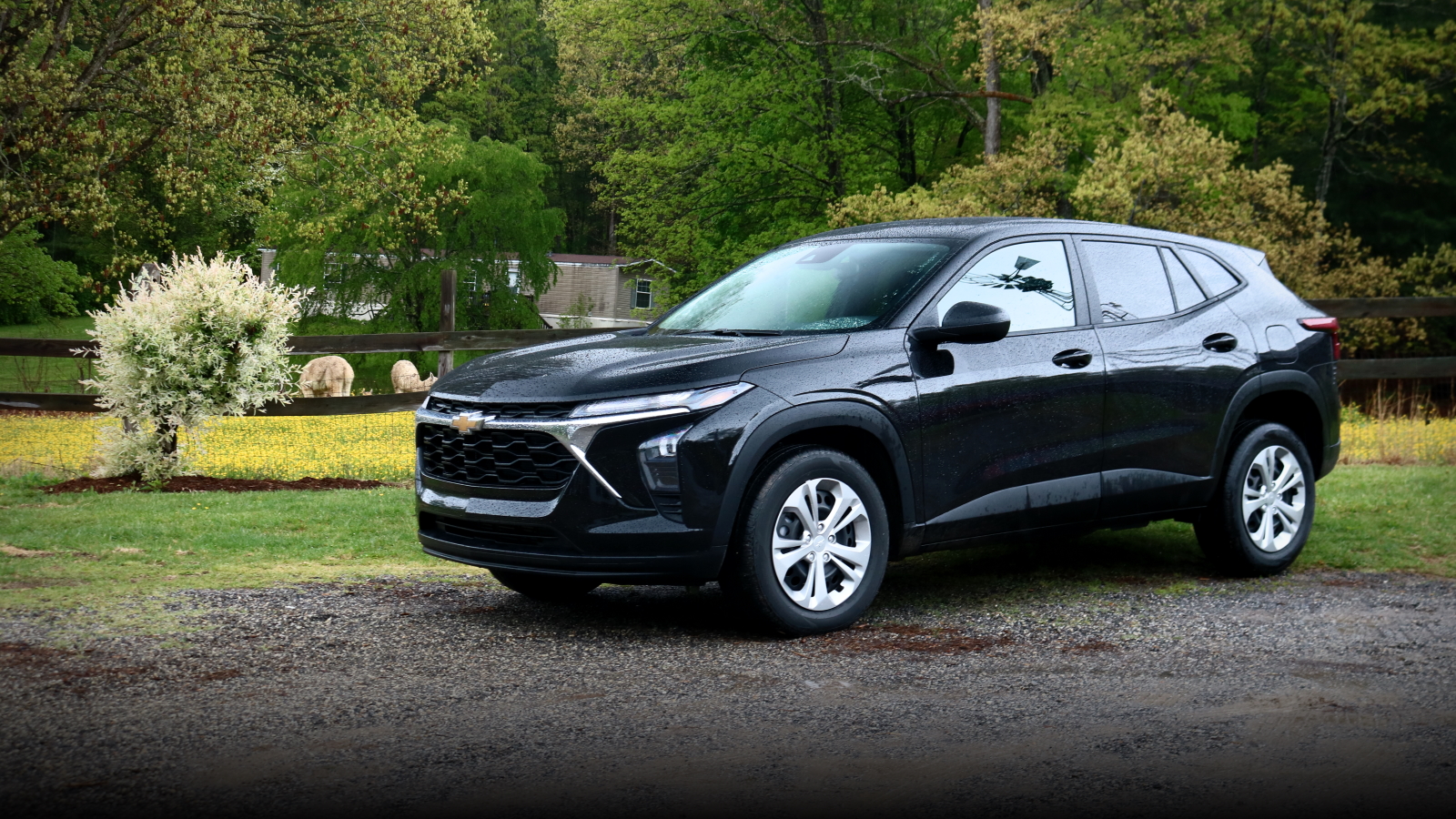
Why? It’s as simple as one headline figure: $21,495. That’s what a base 2024 Chevrolet Trax LS pictured above costs including a $1,095 freight charge ($23,699 including a $2,000 freight charge in Canada), which in this age of premium everything, qualifies as dirt cheap. What’s more, this Korean-built crossover is surprisingly big – almost as long as a Mazda CX-5 or Toyota RAV4. As a result, Chevrolet is expecting huge volume, predicting that the new Trax will be its third-best-selling model behind Silverado and Equinox come 2024. That’s certainly ambitious, but it will only pan out if the Trax is actually good. Needless to say, I flew to Asheville, N.C. to find out.
[Full disclosure: Chevrolet flew me out to Asheville on a series of interesting regional jets and put me up in a room that felt like wealth and sadness at a hotel that used Tesla Model S courtesy cars with some of the most curbed alloys I’ve ever seen in my life. The automaker also offered far too much food for me to possibly eat. Maybe I’m just not used to American portion sizing? Oh, and I got to talk with engineers, marketers, and designers. -TH]
How Does It Look?
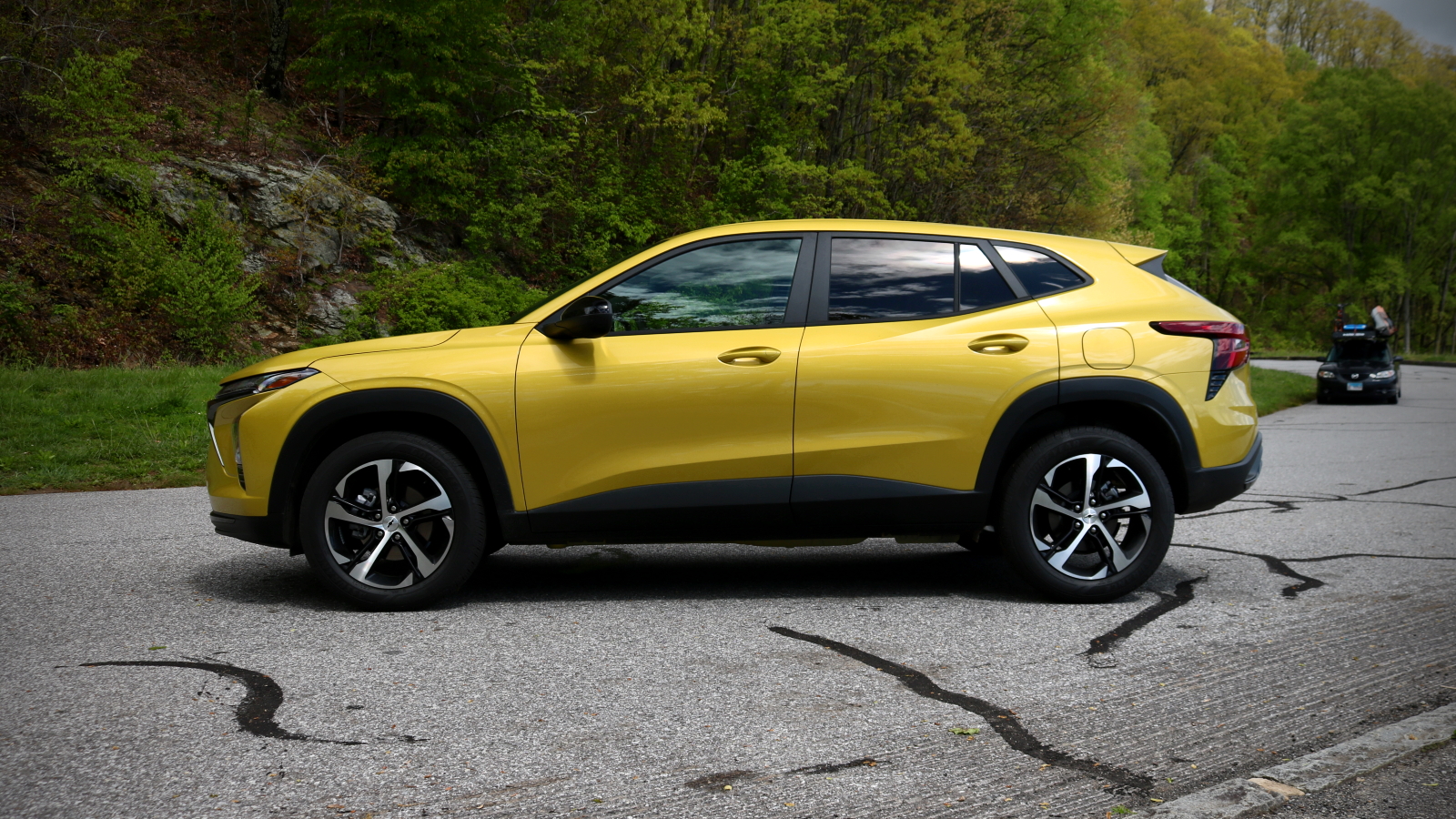
The new 2024 Chevrolet Trax is one of those rare vehicles that’s trying to pull off a reverse catfish. While GM has taken great pains to apply a dab of plastic cladding, pinch the greenhouse and take press photos from low angles, the actual proportions tell a different story. While the Trax may only be about 1.5 inches shorter than a Mazda CX-5, it features a roofline some four inches lower. Plus, front track width and vehicle height are basically 1:1 on lower trim levels. That doesn’t scream crossover by any stretch of the imagination. Indeed, what Chevrolet’s managed to do is sneak 250 milligrams of wagon inside a wrapper of crossover cheese. It even has windows in the C-pillars and the roof appears to just barely cover more than 50 percent of the cargo area (the rear door is deceiving).

As for general appearances, the Trax is busy but still one of the most handsome vehicles in its segment. It feels like the stylists loaded a blunderbuss with character lines and fired it at the side of this entry-level vehicle because my word, is there ever a lot going on. From the flared haunches to the line that runs through the front door handle before sweeping up towards the greenhouse to the fake vents below the tail lights, the profile of this thing seems busier than an Amazon warehouse. However, all the lines are fairly subtle so they just fade into the background in real life, especially if you pick a fun color.
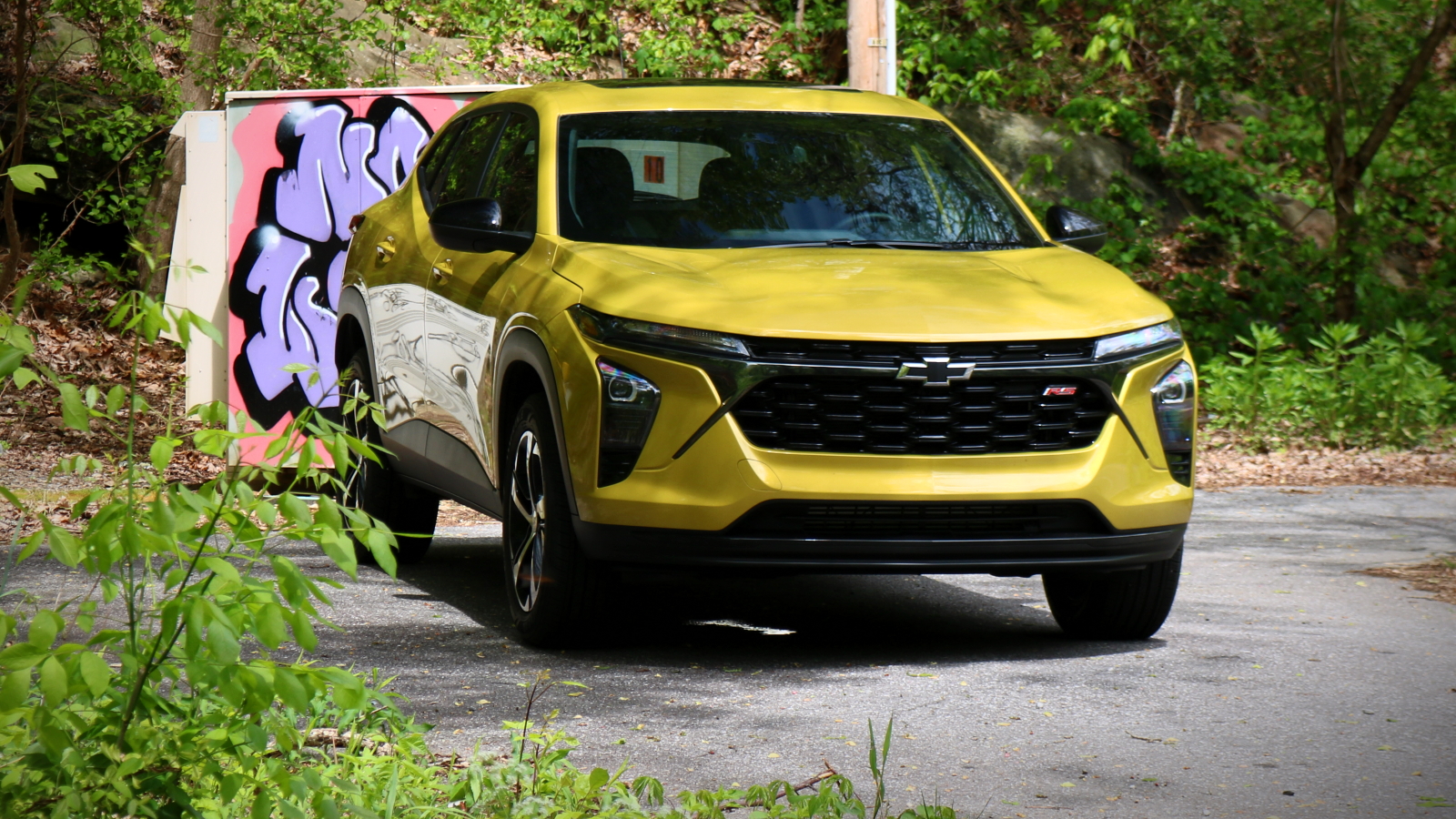
Up front, the Trax features one of the more successful split-headlight applications in recent history, with a distinct down-the-road graphic that makes the Trax instantly identifiable as a Chevrolet. I’m not crazy about the winged chrome accents extending off of the grille, but those can be clipped by going with the Activ trim.

Around the back, things are slightly bland, but in a refreshing and honest way. Think digestive biscuits, water, and oats. Aside from the fake vents below the tail lights, there’s no garish trim nor wild attempt at a ducktail. Everything seems pragmatic, reasonable, and comfortably functional.

Considering how the old Trax looked like a fake car from a banner ad for insurance (see above), I’d call the styling of the new one a huge success. Plus, I’m a sucker for Harley Earl’s philosophy of “lower, longer, wider” and the Trax’s silhouette really overpowers the fussy details. I reckon that in some of the brighter colors, it largely succeeds. Plus, styling in a vehicle like this is really just a wrapper – it’s what’s inside and underneath that counts.
What’s The Interior Like?
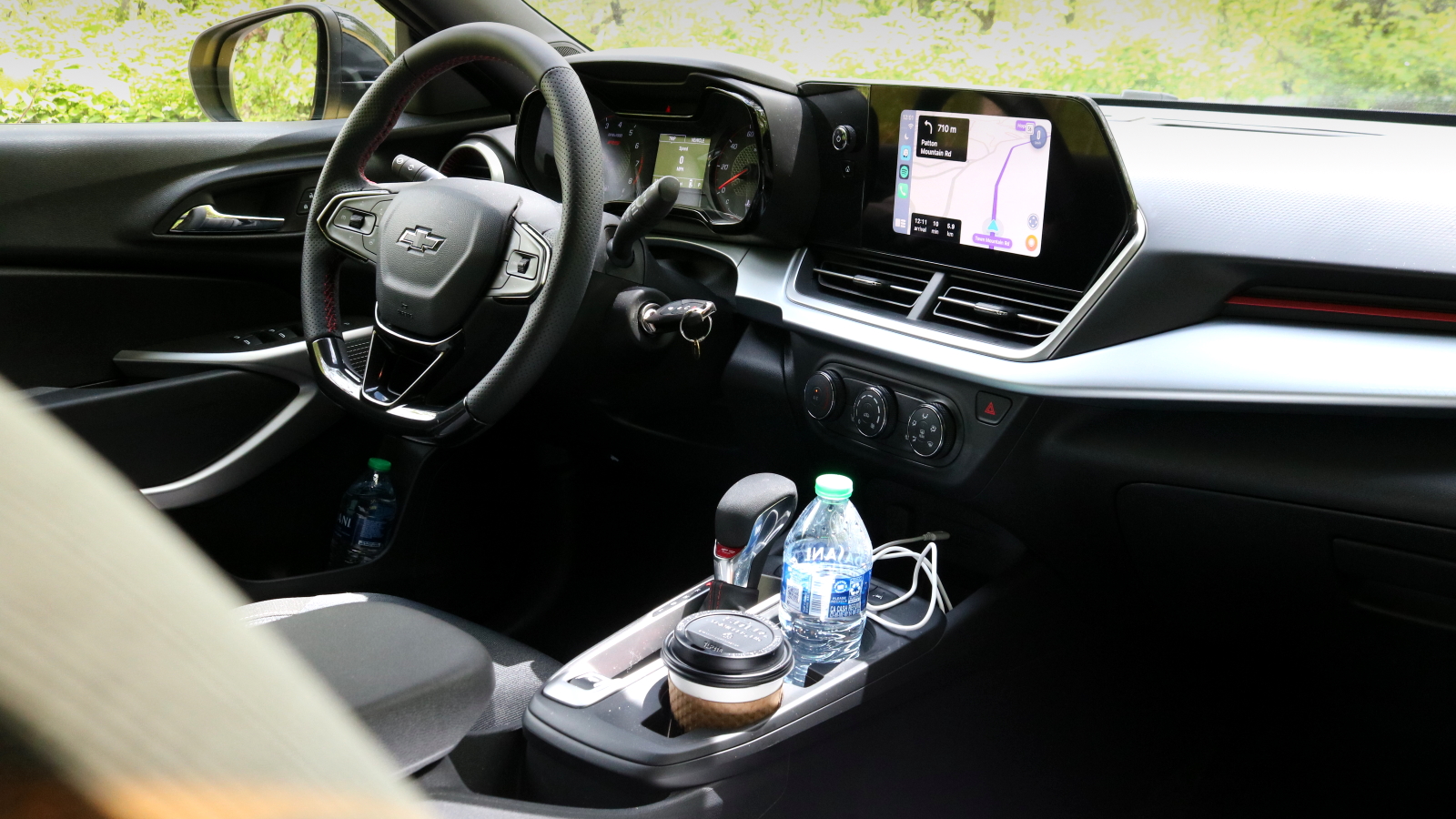
Normally when an automaker puts out a car that’s really cheap for its size, a certain contempt appears as soon as you hop inside. Think the highly-questionable plastics and complete lack of styling in the Jeep Patriot’s cabin. However, we’ve come a long way from the bleakness of the 2004 Chevrolet Malibu’s scratchy, nasty brain matter-grey dashboard, and Chevrolet seems to have learned its lesson.

While it’s hard to avoid hard plastics at this price point, design can sometimes matter more than material. Two identical plastics can appear to be at two completely different price points based on texturing and color. With that in mind, Chevrolet has poured its sweat into making cheap materials look interesting in the Trax, and it shows. The dashboard cap has a fantastic diamond texture that renders it interesting yet hardwearing. It still feels like a Dell laptop from 2009, but the ridges make it fun to run your fingers across. It’s a similar story with the E-Class-aping air vents that aren’t made of anything special but look like jet turbines, and the extreme driver-centric cant of the infotainment screen. The designers claim to have fought long and hard for this interior, and it seems totally worth it.
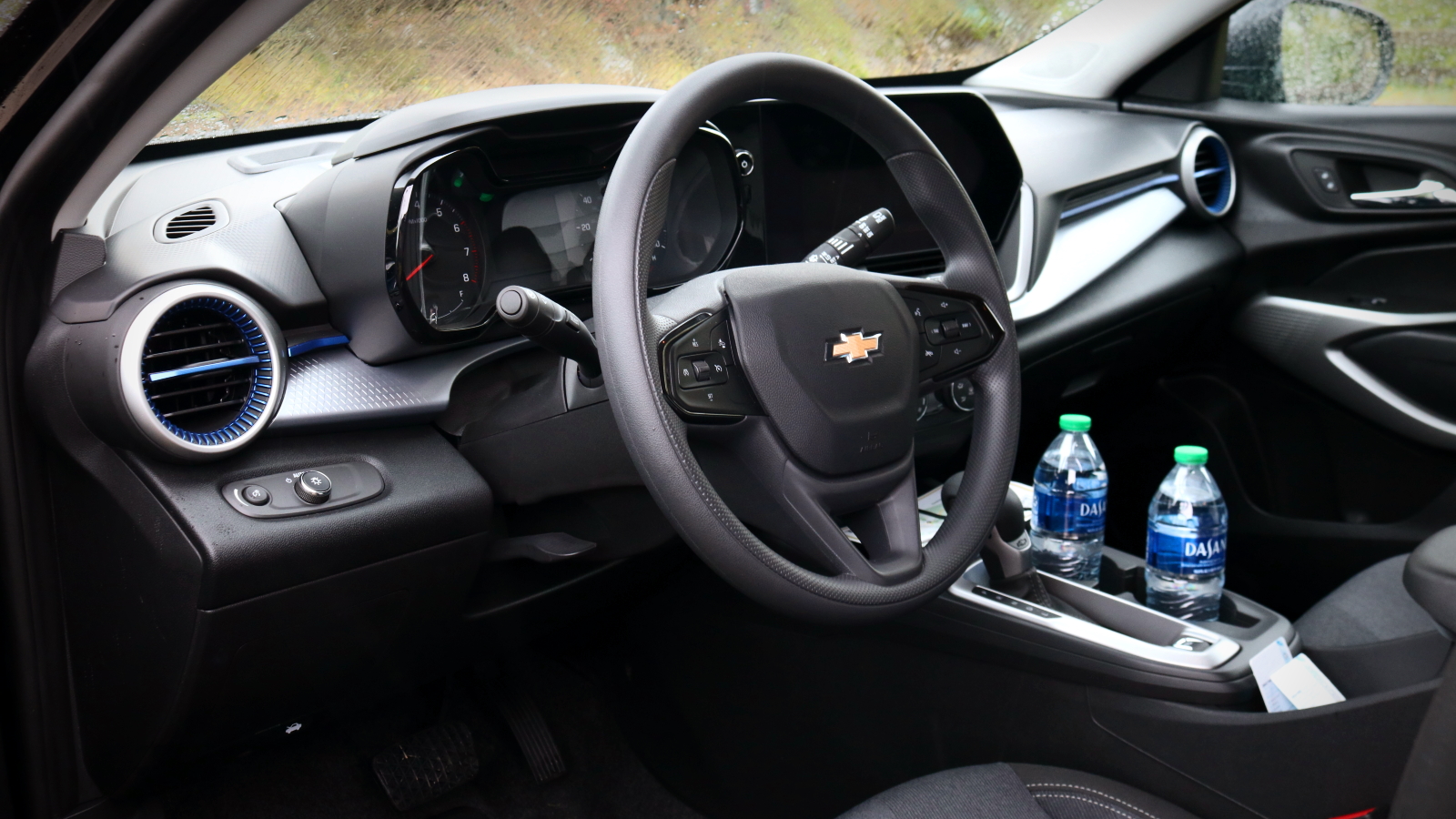
If you’re feeling fancy, you can option a 2024 Chevrolet Trax up with an 11-inch infotainment screen, a digital instrument cluster, keyless start, wireless charging, automatic climate control, adaptive cruise control, and a power driver’s seat. It all sounds very nice but thanks to Chevrolet’s brave decision to bring a base model on the press launch, I can say that popping for a high trim isn’t the move. Nothing feels missing on the base LS trim, and some pieces of low-end tech are actually better than their high-end counterparts. The giant screen on LT and up models is nice, but can get partially-hidden behind the steering wheel rim depending on your driving position. Plus, the base eight-inch screen has a physical home button and still supports wireless Apple CarPlay and Android Auto. The all-digital cluster looks great, but the base cluster with analog dials features easier configurability. Even the base cloth seats are slightly comfier than the uplevel EvoTex faux-leather seats because the material is stretchier.

Since I love my music in the car, best believe I’m dedicating a paragraph to audio. You can get a six-speaker stereo on LT and higher trims, but I reckon the base four-speaker job is plenty. It’s warmer than the uplevel system, with good character for the price point and solid bass reproduction found by running The XX’s Fantasy through wired CarPlay. Sure, you can still get distortion if you crank it, but it doesn’t sound hollow and goes plenty loud before the speakers start to knock. Playing Nordpool Orchestra’s version of Weird Fishes shows decent texture, and vocals on wall-of-sound tracks aren’t drowned out. Don’t expect perfection or even deep-hitting sub-bass, but I’ve heard worse stereos with actual brand names attached.

Open a rear door and you’ll find that the Trax has a completely flat rear floor, thanks in part to being front-wheel-drive only. When you just have to run an exhaust pipe the diameter of a falafel and some tiny brake lines from ahead of the driver to behind the rear seats, a flat floor becomes a no-brainer. Add in three more inches of legroom than the outgoing car and you have a comfortable rear seat for three people. Hell, this cheap little crossover has nearly as much rear legroom as a Toyota Camry. Subcompact? Yeah, right. Unfortunately, likely because of the price point, rear seat amenities could be better. There’s no rear center armrest available, which means that the middle position is very comfortable but the only beverage receptacles are bottle holders in the rear doors. While the phone cubby in the back of the center console is useful, a set of fold-out cupholders would be much appreciated.

Behind the second row, you’ll find 25.6 cubic feet (724.9 liters) of cargo space with the rear seats up, expanding to 54.1 cubic feet (1,531.9 liters) with the rear seats down. While the second-row seats don’t fold perfectly flat, the lip is small enough that it shouldn’t be a huge issue to get cargo in and out.
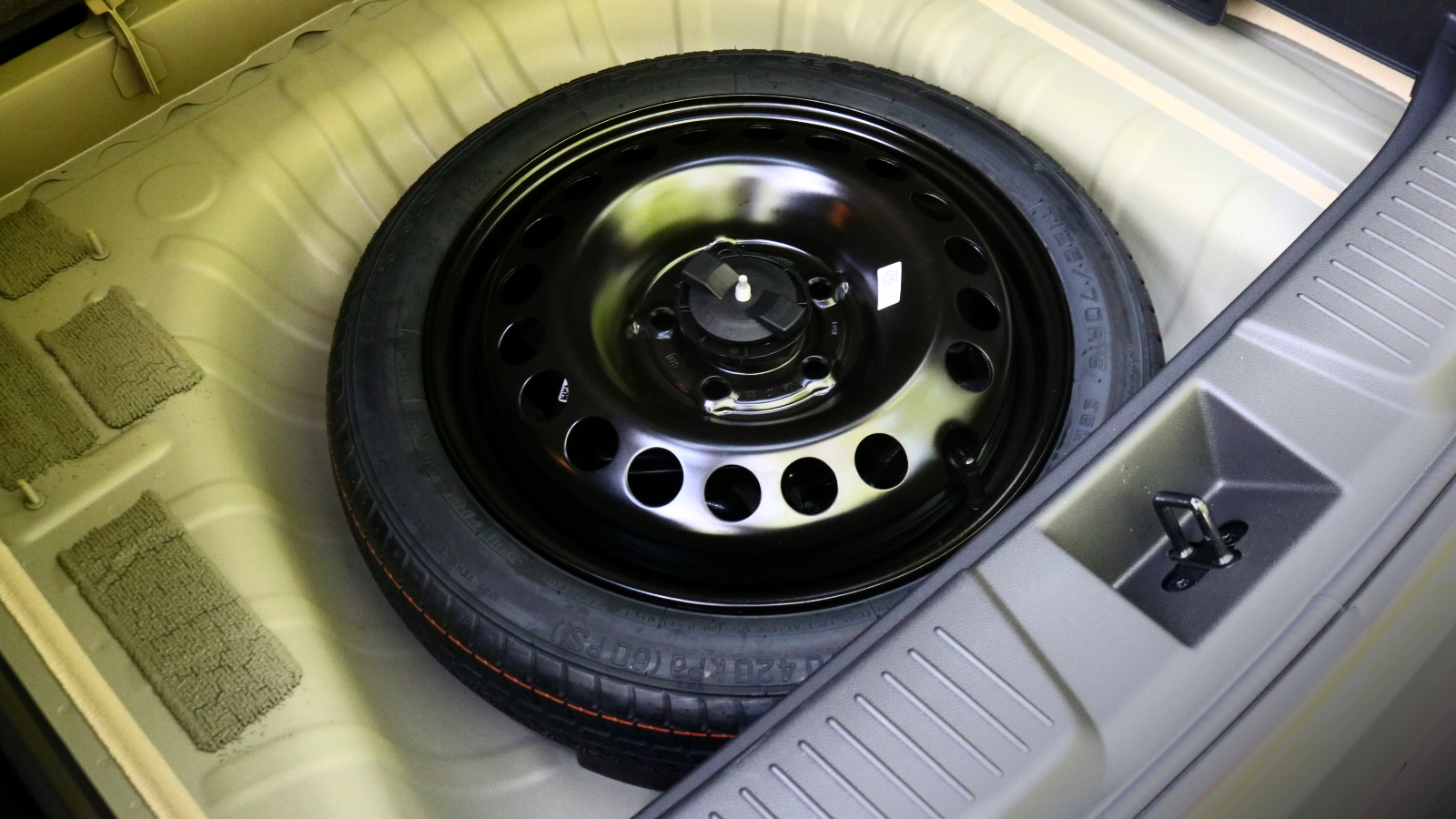
Speaking of the cargo area, lift the false floor to discover a feature from a bygone time – an actual spare tire. Sure, it’s a donut, but it’s a sight for sore eyes in an age of inflator kits. As to be expected in most cars at this price point, the under-floor compartment doesn’t have a full coat of paint over its e-coat corrosion-resistant coating. Although the spare tire well is an unlikely area to accumulate moisture, it’s something worth checking down the line.
How Does It Drive?

Powering the front wheels of every 2024 Chevrolet Trax is a 1.2-liter three-cylinder engine mated to a six-speed automatic, a combination that should in theory feel like a Cuisinart gyrating a vat of custard. Three-cylinder engines are inherently imbalanced and a six-speed-automatic with wide ratios is so ten years ago. However, because the three-cylinder engine has very good stop-start and a turbocharger the size of a literal snail, it’s dead silent at traffic lights and makes 162 lb.-ft. of torque from 2,500 RPM to 4,500 RPM. This means the Trax dashes from zero-to-60 in a claimed 8.6 seconds, which is about as quick as a Toyota Corolla Hatchback despite a 32-horsepower deficit. More usefully, the Trax is properly punchy around town, which makes turning left onto a four-lane road a breeze.
Torque is good, but how about fuel economy? After all, a tiny turbocharged engine can sometimes be less efficient in the real world than a larger naturally-aspirated one if you’re always in boost. The Trax is rated by the EPA at 28 mpg city, 32 mpg highway, and 30 mpg combined. That works out to 8.3 L/100km in the city, 7.4 L/100km on the highway, and 7.9 L/100km combined in Canada using metric units. Those aren’t brilliant figures, but from my experience, they’re absolutely achievable. No matter what I did, the Trax always seemed to get around 30 mpg. Punishing the front tires on a mountain blast? Around 30 mpg. Cruising on the highway? Around 30 mpg. Slogging through suburbia? Around 30 mpg. It’s not the greatest number in the history of the world, but I appreciate the consistency.

Ride quality comes with a disclaimer – Asheville, N.C. isn’t a city renowned for its potholes. When planning these great big press launches, manufacturers often pick locales with mirror-smooth roads. That being said, the Trax rode admirably over the minor imperfections I managed to find. Sure, there was some expected road noise at freeway speeds, but it never grew loud enough to hinder conversation. Impacts were heard rather than felt through the suspension, although that doesn’t mean the Trax is totally isolated.
Here’s a shocker: Despite the high-profile tires and comfortable ride quality, the Trax’s steering wants to reach out and touch base. It can offer a slight nudge as road camber dramatically changes, a pronounced rumble over broken pavement, and a very minor jolt over expansion joints. It doesn’t exactly turn tarmac into braille, but when combined with pleasant weighting, it feels more connected than the steering in most modern compact sedans.

As for hardware, there’s nothing fancy going on underneath the Trax. You get MacPherson struts up front, a torsion beam in the rear, and electric power steering, same as pretty much every entry-level crossover. I reckon that’s good news as this simple setup should simplify suspension maintenance in the long-run. Unexpected for this size and price point is the presence of four-wheel disc brakes with a pleasantly firm pedal that offers confident feel and easy pedal modulation.
What’s The Verdict?
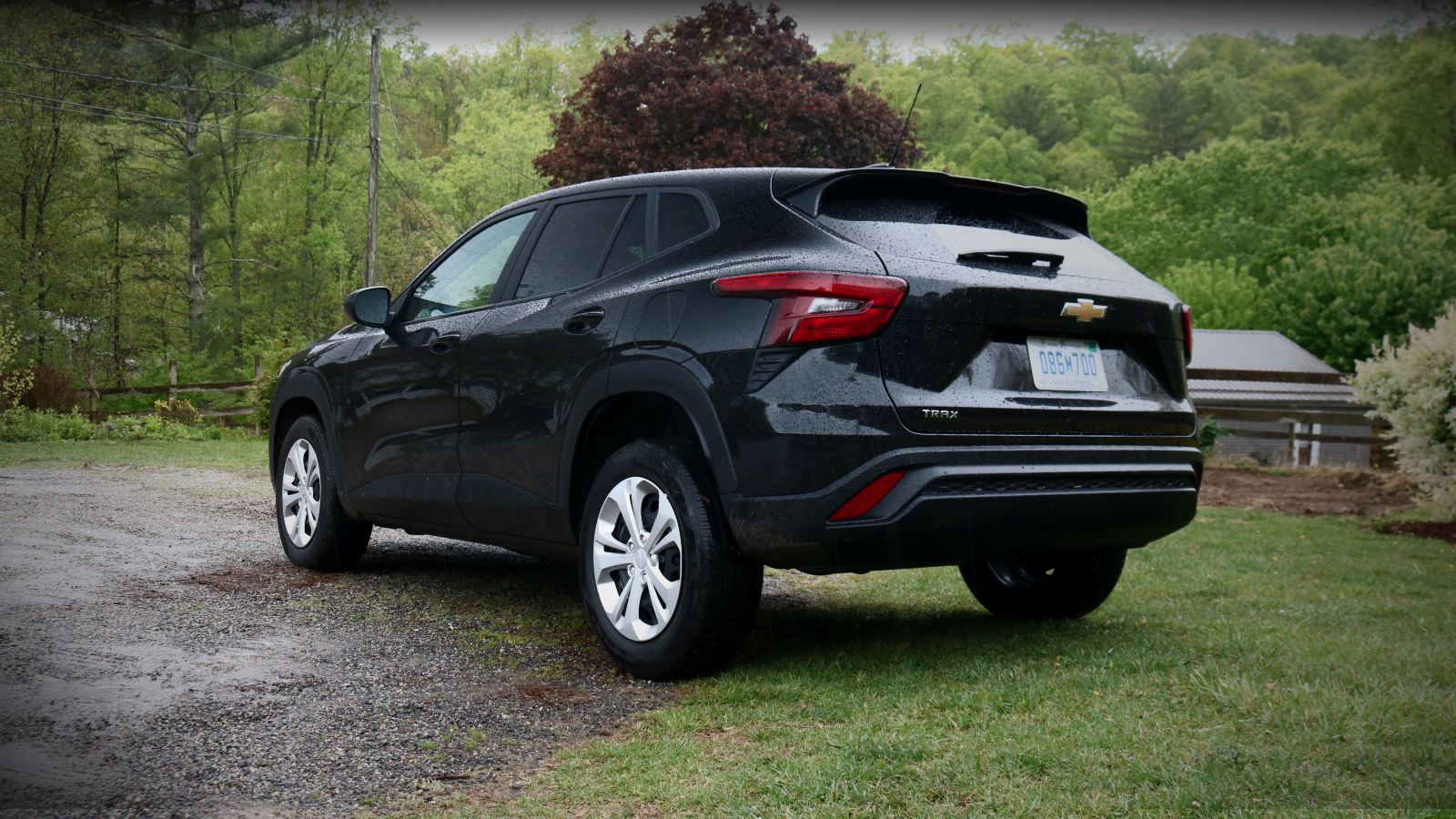
Upon first drive, the 2024 Chevrolet Trax is great. As the miles ticked away, I found more and more to like about this reasonably-priced and spacious crossover. It’s the sort of car I’d recommend to my parents, who want a true replacement to their dearly-departed Toyota Matrix. Hell, I’d love one as a daily. There’s something awesome about a simple, economical vehicle that won’t high-center in the snow and can haul oversized car parts. With used car prices being higher than Godzilla’s left nostril right now, the Trax is something to buy new, maintain, and just keep driving until it’s all worn out. It’s as cutting-edge as it needs to be, techy enough to fit in with modernity yet simple enough to not age like milk.
While the seat time afforded on a typical press launch isn’t enough to learn everything about a car, it’s plenty of time to know if something feels obviously substandard. For example, the Nissan Kicks isn’t exactly quiet and the Hyundai Venue feels like it’s flirting with the FAA when driving on concrete freeways, and I formed those impressions within the first ten minutes of driving either. Over a few hours of driving the Trax, I couldn’t find anything inappropriately poor. I suppose that if I’m nitpicking, more rear seat cupholders would be nice, but that’s it.

As far as similarly-priced competition to the $21,495 Chevrolet Trax LS, you have the Nissan Kicks S at $21,775 including a $1,335 freight charge, the Kia Soul LX at $21,215 including a $1,325 freight charge, the tiny Hyundai Venue at $20,985 including a $1,335 freight charge, and that’s it. Literally every other subcompact crossover is noticeably more money. Actually, here’s a list with all prices including freight charges: The Toyota Corolla Cross L costs $24,395, the Honda HR-V LX costs $25,395, the Hyundai Kona SE costs $23,475, the Kia Seltos LX costs $25,715, the Mazda CX-30 2.5S costs $24,325, the Volkswagen Taos S costs $25,450, the Jeep Renegade Latitude costs $29,150, the Fiat 500X Pop (they still make it!) costs $29,560, the Mitsubishi Outlander Sport 2.0 S costs $24,595, and the Buick Encore GX Preferred costs $27,195.

While I haven’t driven a Soul in a while, I can confidently say that the Trax is flat-out better than the Nissan Kicks and Hyundai Venue, and it’s better value for money than any other subcompact crossover on sale today. In Canada, only the Nissan Kicks S and Hyundai Venue Essential undercut the Trax LS, with major competitors like the Kia Seltos LX, Toyota Corolla Cross L, and Honda HR-V LX costing thousands of dollars more.

The Chevrolet Trax isn’t as refined or as premium as a Mazda CX-30, but it doesn’t need to be. Instead, it poses a more important question: Why don’t we just make regular-ass cars that people can afford again? Although even a fully-loaded Trax 2RS or Activ with the optional premium paint, Driver Convenience Package, and sunroof stickers for a very reasonable $26,935 ($31,589 in Canada), I reckon the picks of the range are the $23,195 1RS trim in America and the $23,699 LS trim in Canada, mostly because those are the entry points for heated seats. Beyond that, everything feels unnecessary. It’s good enough to enjoy yet uncomplicated enough to not worry about. Learn to love the fundamental goodness of this entry-level crossover and you just might find automotive enlightenment.
(Photo credits: Thomas Hundal)
Support our mission of championing car culture by becoming an Official Autopian Member.

-
The 2024 Chevrolet Trax Looks Like A Deal For $21,495
-
The Hero Of The LA Auto Show Was This Dirt-Cheap Kia Rio
-
The Sharp 2024 Hyundai Kona Lets You Pick Between Two Gas Engines Or 260 Miles Of Electric Range
-
The Chevy Bolt Is Officially Dead
-
The Dirt-Cheap Mitsubishi Mirage Is Getting A Ralliart Edition And It Might Look Like This
Got a hot tip? Send it to us here. Or check out the stories on our homepage.




I’ve reread this (and other) review(s) of the Trax a few times, and each time I do, I find myself becoming more and more curious about it.
Of course, the utopian/curmudgeonly part of me wishes it could be had with a manual transmission, and/or there was a plug-in/hybrid version, but even as-is, it really seems like a decent car to buy and then just use as a car for as long as possible.
If I wind up buying one of those instead of a hybrid Maverick XL, Ford will only have itself to blame for not building enough Mavericks (and dealer markups).
I’ll take mine in that Cacti Green.
🙂
An affordable(ish), normal car. Imagine that!
So I’m going to be renting this at every rental counter for the next few years? I mean there are no other cars/SUVs that fit that market so well.
Thank you for the informative review of an interesting and interestingly priced car Thomas! 🙂
Serious contender for “largest generational improvement.” I can’t properly express how much I hate the “short, squat, jacked-up hatchback” look on the current gen, Ecosport, and the like. This is much, much better.
I don’t like crossovers and would never buy one, but bravo, Chevy.
“A six-speed-automatic with wide ratios is so ten years ago.”
Funny, I remember reading not quite that far back when asked why they went with a 6AT on the Skyactiv line Mazda claimed 6 gears was the sweet spot, any more was diminishing returns.
“Why don’t we just make regular-ass cars that people can afford again?”
Define “afford”. Because my definition is clearly not the norm and I’m guessing neither is yours.
The kid turns 16 in about a year and I’ve compiled a list of cars I’ll go halvsies with him on. This one is on the list, the Maverick tops it, but it’s unobtanium. Good for Chevy for embracing the suck without entering penalty box territory. There are some great cars (trucks…cuvs) now at that 22k-24k range that seem like the sweetspot. When a 20 year old ranger in good condition goes for 10k, these things look better and better all the time. This thing meets 2023 safety standards, getting that 30mpg and coming with a warranty- which to me is worth every additional penny.
You wrote “winged chrome accents extending off of the grille” but what you really meant was “catfish whiskers”
Those of you who wish the Dacia Sandero was sold here – this is probably as close as you’re going to get.
Good work GM for realizing that for many people a car is just a transportation utility, but can be a good one.
Not so great though: “lower, longer, wider.” Lower doesn’t help people with old joints nor those who are 6″2″+ with am uncomfortable upper sight line. Many garages and parking slots struggle with wider and longer.
No doubt the MBA’s at GM know how to optimize sales and profit. But there is an opportunity here for a car for adults who care about function and ergonomics, but don’t give %$^#$ about appearance.
Um, it’s not like this thing is a slammed 90’s Integra. I’m sure this will be very friendly to folks who want to slide right into the drivers seat. The only way to do this better is the box-car-a-la-Kia-Soul and at that point, the Soul is still available.
This is an interesting complaint in a world where damn near every available car is as tall or taller as I am. There are plenty of options.
But most are small suv’s > 70 or 71″ wide. The saab 9-3 is a mere 67.4″ wide although not that high off the ground at 3.9″. Why not 69″ wide and, say, 5″ ground clearance? Of course the seat height doesn’t necessarily follow in proportion to the clearance – several variables here. I’m 6’1″ and plenty of head-room. The main user, my GF, finds the enter/exit a little painful. Yea, we are old people and there plenty of us. Unfortunately the saab is at end of life and going downhill fast.
I’m still waiting for an article from you guys on the idiotic model names that the American market has: Trax, Sport-age, Carnival, Compass, Captiva, Tracker, Onyx, Cruze, Edge, Territory, etc. Seeing the name already lost me.
Better than 332XCR TX AWD
This is about as American as the Aveo. With the price in the low 20s many will find it an easy purchase. It will probably be better in the long run than most GM products, but hopefully no one will assume that the Trax is genuine Detroit iron. And 30 MPG from a 1.2 liter engine is pathetic.
I’d rather have genuine Seoul plastic than genuine Detroit iron given the history of quality of the latter.
There was a time I would have argued the other way, but that stopped around 15-20 years ago. And looking at the Kia and Hyundai that occupy my garage, I have put my money where my mouth is.
> It feels like the stylists loaded a blunderbuss with character lines and fired it at the side of this entry-level vehicle because my word, is there ever a lot going on. From the flared haunches to the line that runs through the front door handle before sweeping up towards the greenhouse to the fake vents below the tail lights, the profile of this thing seems busier than an Amazon warehouse.
That’s a brilliant description. You and Torch are like Robin Williams and Jerry Seinfeld after a few drinks.
Also, hard LOL at this.
> Powering the front wheels of every 2024 Chevrolet Trax is a 1.2-liter three-cylinder engine mated to a six-speed automatic, a combination that should in theory feel like a Cuisinart gyrating a vat of custard.
…no 3-pedal option?
Crackpipe.
I don’t know why I like this thing as much as I do. Maybe it’s because I’m a Pontiac Vibe faithful that loves a good, affordable (not cheap), practical car. But more than that, Chevrolet has seemingly made a good small car. That’s incredible. If I see one on the rental car lots when traveling you can be certain I’ll try it out.
Great review Thomas! Hopefully you had a chance to bounce around Asheville a bit, flip through some record stores, and enjoy some great craft beer. Always one of my favorite cities to visit.
I know that a lot of people bemoan the lack of entry-level cars on the market today, but GM is really stepping up its offerings with the new Trax, Envista and Trailblazer. For the Trax, a starting MSRP of $21,495 in 2023 is about equivalent to $17,408.78 in 2015 when considering inflation. That was about the starting MSRP of the brand new entry-level car I bought in that year (Chevy Cruze). Honestly not a bad value considering that this thing appears to be much nicer than the entry-level vehicles of that era for roughly the same inflation-adjusted price.
The market is screaming for a compact crossover under $25K that isn’t a cheap ass penalty box (looking at you, Ford “Echo” Sport), and I’m sure this thing will be quite popular if it’s as you’ve described. For Autopians, probably not. But for the general buying public I’d imagine it will be a hit. An inexpensive tallish, stylish (for the class) vehicle with seating for five that gets decent gas mileage and has room to haul stuff. That’s a winning formula. To be fair, it doesn’t have AWD, but almost no one actually needs AWD. That’s also one of the things most responsible for the price bloat that we’ve seen over the past decade.
Let’s have a conversation about how normies (and probably most of us) use their cars and compare this to the use case.
Normies want to get in the car and go with minimal hassle or thought to the matter. – CHECK.
Normies prefer the ease of driving a reasonably sized vehicle – CHECK
Normies need to occsionally move other people or some larger objects. – CHECK
Normies can spend extended periods in thier cars commuting and will collect flotsam and jetsam and dirty up their interiors. Normies don’t want to spend lots of effort and time cleaning their dashboard of the grime that will inevitably arrive – EPIC FAIL
That dashboard is a travesty of pointless shapes, crevices and floating panels that will look like shit in no time. Maybe some enthusiast will like detailing their car every few weeks, but for normies, this is just bad design.
Actually looks great for the price and segment. I have to wonder how much cheaper a 1.2 turbo is to make than a normally aspirated 2.0 that would tend to last longer with less maintenance and provide more power and likely better real world mileage. Maybe it’s more of a packaging solution, though it doesn’t look too jammed up in there.
The 2.0l NA engines in the competition are pretty gutless (and most are paired with CVTs). That’s why I was honestly surprised about the acceleration stat for this car. 8 1/2 seconds is good in this segment, most of the competition are around a second slower (at best). That alone would put this car at the top of my shopping list if I were looking in this segment.
I don’t need a fast car, but I do need a not-slow car, if that makes sense.
I agree that acceleration is not bad at all, but I don’t think a 2.0 N/A would be worse even if it would feel slower at low rpm. I was assuming the same transmission so to be apples to apples. My ’12 Focus had 160 hp and 146 lbs ft. Though not as flexible torque, it was a pretty unstressed engine that never felt weak and needed nothing but oil changes and a spark plug change in over 200k miles of traffic and aggressive driving. I would think someone buying a low end car like this would prefer it last with the lesser maintenance of an N/A, plus this probably wants* premium fuel an N/A wouldn’t need. Speaking of transmissions, the lower torque of the N/A 2.0 would help with longevity there, as well, though that may be academic as it’s not like this 1.2T is a monster. But mainly, I’m wondering if or how it’s cheaper to make a 1.2T instead or what the consideration was. Maybe it’s as simple as these small turbos game EPA testing better or that they only make the 2.0 in turbo and it would cost more to manufacture a N/A version, IDK. I’m just curious about the manufacturing side of this, I think it’s pretty impressive for the price as it stands.
*it might or might not say it can deal with regular, but IME, that means a fair hit in mileage and power as the timing has to be pulled back.
Looks decent. It’s screaming for a hybrid version.
I drove the prior generation of this in its Opel clothing as a rental car in Europe for about 1000 miles, including over multiple passes in the Swiss alps. Maybe the engine and transmission has improved but I didn’t find it’s ability to accelerate quickly off a dead stop or up a steep hill to be reassuring.
Exterior: Surprisingly good
Interior: EV manufacturers should take some cues from this. It’s so much better than the nightmarish screen-filled abominations in every “high tech” car.
MPG: Disappointing, but not a dealbreaker.
Overall seems like a winner to me.
I was in Detroit this past weekend and saw a couple of them; they look pretty good. I graduated from these sorts of cars ages ago; but for someone like my sister who wants something that’s new and will seamlessly slot into her life, all without costing $1m, it seems like this’ll be tough to beat. In other words: GM built a good entry-level car. Praise be.
The styling looks great.
A height to with ratio of 1:1 excludes this from being considered a car or wagon, so what we
have here is a squatting SUV that gives up room for styling, but will not have the stability of a car.
Acceleration is acceptable, but let’s face it, this is underpowered for its size, and that 3 banger buzzing away under all the sound deadening is not likely to be reliable.
For enthusiasts, this segment has nothing to offer.
After seeing how long the list of competitors is for this segment, I think I need some strong anti-depressants.
You just described this entire segment. It seems like all automakers are suddenly putting very small-displacement engines in these type of cars now, presumably in a cynical ploy for “efficiency”. (Hey guys, if an engine is underpowered for its application, then by definition it is not efficient!) Still, I would take the torque in this one over what most of the competition is offering.
Looks pretty good, I feel better about the six-speed auto than a CVT.
It has to be better than the previous one. I rented a 2015 Trax to drive my family of 3 from Raleigh, NC to Disney World in the spring of ’15. I came away from that experience learning two things:
1) A B-segment sub-compact CUV is a perfectly viable family hauler and road trip car for a family of 3.
2) That B-Segment sub-compact CUV should NOT be a Chevy Trax.
A few months later I purchased a turbo manual Jeep Renegade and have been enjoying it ever since.
Perhaps this new Trax can change point #2.
Since you drove it around Asheville, I’m curious how such a small, low-powered engine handled climbing the hills on the Interstate around there?
I’m glad you asked. Even with the occasional kickdown, long ascents were handled fairly well. The powertrain control module generally kept the revs below 3,000 and just let the turbo come online to do the hard work. Overtaking slow trucks on steep hills wasn’t a problem either, as the Trax would kick down and jet up to the flow of traffic reasonably quickly. It’s definitely not a performance vehicle, but it never felt slow or labored.